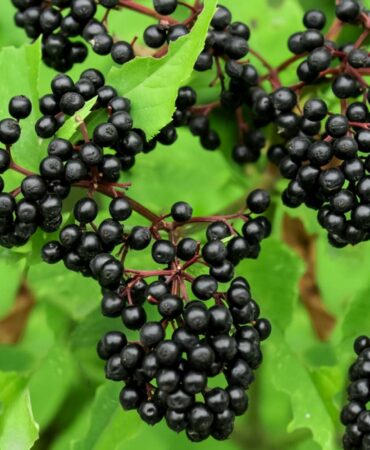Currently Empty: £0.00

Herb Histories: Birch – Wine, Oil and Tar
Deep-rooted and deeply-rooted within the European landscape, the Birch tree has been a part of the natural landscape since before there were written records of history. It’s called a pioneer species meaning that it easily inhabits barren environments, and is one of the first trees that appeared after the final Ice Age. It’s presence in the landscape reaches the Asian Minor, and it’s even one of the only trees native to Iceland. Popular as much a garden tree as it is part of a woodland, the Birch has extensive cultural meaning and medicinal value in addition to its attractive appearance. Here to explain is Helen, and so, let Herb Histories with Helen begin…
Written by Helen Miller
Today many people recognise Birch trees, particularly the distinctive Silver Birch. They were magic trees for Nordic people and have many recorded historical uses for their essential oils. Are we overlooking a valuable herbal resource?
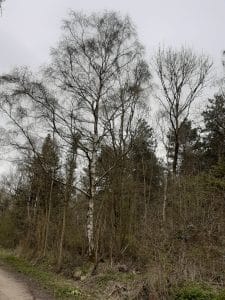
What’s In A Name?
The Old English name for Birch was ‘berc’ or ‘birce’.7 It represented the rune ‘b’, the first symbol in the Celtic Ogham Alphabet and was known as ‘beorc’, a variation of the word for ‘birch’.10 The Birch has long been associated with femininity, chastity and purity. It has been suggested that the words ‘birch’ and ‘bright’ might have a common root. Possibly due to the pale, cream colouring of the tree.8
Birch trees were associated with protection. For example, they were used to make shields and the trees themselves were thought to prevent mishaps in the house, such as burning cakes. They were also associated with protecting against being struck by lightening and Birch trees were thought to never have this happen to them.8
The scientific name for the Silver Birch tree is Betula pendula. The name Betula is thought to come from the Latin for Birch. Betula could have been based on the Gaulish word ‘betu’ meaning ‘tar’ because apparently, according to Pliny, the Gauls extracted tar from the bark of Birch trees. People of Dutch ancestry in Pennsylvania apparently still use Birch tar as an analgesic (pain reliever) and stimulant, as well as making it into a type of beer.
The second part of the scientific name is pendula. This comes from the Latin for hanging and is the plural for the word ‘pendulum’. Presumably this is in reference to the many hanging, swinging branches of leaves.
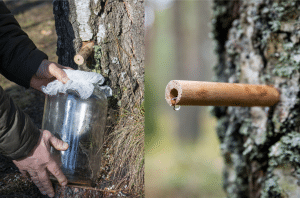
Birch Sap Tapping
Any tree can in theory be tapped, but it is important to make sure the tree is 25-30 cm in diameter. Tapping a tree when it is any smaller can damage it. Moderate tapping does no harm to the tree and a large tree can provide 16-18 gallons of sap.7
To obtain the sap a hole is drilled into the tree at an angle of 30 degrees downwards, so that it just penetrates through the bark. The hole needs to be just wide enough to insert a piece of tube for allowing the sap to drip into a container.7
Birch sap is thin and sugary. If it smells at all the it indicate that the tree has caught a fungal infection. The sap should then be discarded and is why care is required when drilling the hole. When tapping is finished the hole in the tree should be plugged using either a piece of cork and wax.7
Birch sap only keeps for a few days in the refrigerator but freezes well. It can also be fermented. It can be combined with honey, cloves, lemon peel and fermented with yeast, which “…makes a very pleasant cordial” according to Mrs Grieves.6 There are also many Birch Sap wine recipes available on the internet.
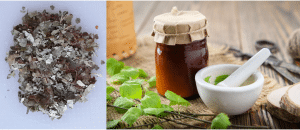
Birch Oil and Tar
The white bark epidermis of Birch trees can be separated into thin layers and used like an oiled paper for various economical uses. The oil of Birch is acquired by heating the bark to release the oils through distillation. This gives what is known as the ‘essential oil’ of Birch. This oil was once used to make leather more durable and waterproof.6
Reducing the oil further results in a sticky, black tar that can be used as a glue. People are thought to have used the tar as one way of attaching arrowheads to shafts. It was also used as a gum.
The production of Birch Tar was a big industry in Russia and it was also distilled in Holland and Germany but the oils produced in Holland and Germany were very different to the Russian ones. Apparently, the oil was used to keep away insects and prevented insect bites.6
Traditional Uses of Birch
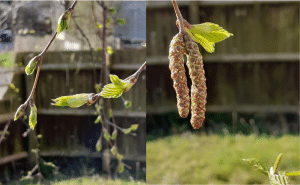
The use of Birch sap has been common through the centuries. Surprisingly, however, Gerard says there is nothing known of Birches medicinal value.5 Culpeper on the other hand recommends using an infusion of the leaves, decoctions of the bark and the buds with small twigs and a distillation of the sap as a cure for kidney or bladder stones.4
The young shoots and leaves were used as a tonic laxative and the Birch leaf tea was used for gout and rheumatism and again for breaking down kidney stones. Together with the bark they were used for soothing skin eruptions. The oil was similarly used for skin conditions, such as eczema, due to its astringency. The Spring birch sap was used as a diuretic.6
Another of the traditional uses for Birch prior to the sixteenth century was as a splint. The Birch bark was soaked in water until it was soft. Then the bark was carefully placed along the limb and tied with pieces of the bark. Once dry Birch bark becomes stiff and firm again, and was able to give the limb support as it mended.3
Modern Uses of Birch
Some species of Birch, including B. pendula, have indeed been found to be useful in the treatment of degenerative joint disease, such as arthritis and rheumatism, and also gout. They also exhibit anti-inflammatory, immunomodulatory, antioxidant affects and anti-tumour affects. This is a change from its traditional use, which has mainly focused on skin conditions and others as mentioned above.9
There were not many traditional herbs used in the treatment of tumours and cancers but the ones that were used seem to modulate the cell cycle. The constituents of Birch, specifically botulin and betulinic acid, are involved in stopping tumours proliferating.1, 9 When Birch is administered properly, there are no known contraindications.1 Thus, this graceful tree definitely has many benefits that we should appreciate, aside from its beauty.
Helen is a freelance copy and content writer, enthusiastic about science and history. To learn more about her work visit her Linked-In profile.
Note: The Herb Society UK always advises that you consult a licensed practitioner of any alternative medicine before starting treatment. This blog is written for educational purposes only and should not be interpreted as medical advice.
References
- Al-Snafi, A. E. (2015) The Medical Importance of Betula alba – An Overview, Journal of Pharmaceutical Biology, 5(20):99-103
- Barker, J. (2001) The Medicinal Flora of Britain and Northwestern Europe, Winter Press.
- Clark, W. A. (1937). “History of fracture treatment up to the sixteenth century”. The Journal of Bone and Joint Surgery. 19(1): 61–62.
- Culpepper, N. (1653) Culpepper’s Complete Herbal: consisting of a comprehensive description of nearly all herbs with their medicinal properties and directions for compounding the medicines extracted from them, W. Foulsham & Co., Ltd., London.
- Gerard, J. (1633) The Herball: A General Historie of Plantes.
- Grieves, M. (1998) A Modern Herbal, Tiger Books International, London.
- Hamilton, A. (2020) Birch Sap Wine and How To Tap A Birch, The Other Andy Hamilton blog,https://www.theotherandyhamilton.com/birch-sap-wine/ (Accessed 5th April 2021).
- Pollington, S. (2011) Leechbook: Early English charms, plantlore and healing, Anglo-Saxon Books
- Ratstogi, S., Pandey, M. M. and Rawat A. K. S (2015) Medicinal plants of the genus Betula – Traditional uses and a phytochemical-pharmacological review, Journal of Ethnopharmacology, 159:62-83.
- Wigington, P. (2019) Ogham Symbol Gallery, https://www.learnreligions.com/ogham-symbol-gallery-4123029(Accessed 5th April 2021).




